Chord Progressions
Chord Progressions are very popular and a strong foundation for many instruments and songs. Any chords
combined together in an intro, verse, chorus, bridge, etc. becomes a chord progression. This movement builds a foundation for a
song’s harmony and sometimes rhythm too. Some chord progressions derive from a scale, and the notes in that scale
help build chords and chord progressions, just like the harmonized scales from the scale’s
section previously discussed.
For example, a Blues style song in the Key of A (A, B, C#, D, E, F#, G#) has a variety of options constructing the chord progression. It
could use a simple I-IV-V (A, D, E) chord progression, which is commonly used in 12-bar Blues. Dominant seventh chords are great chord
substitutes in Blues chord progressions, turning I-IV-V into I7-IV7-V7 (A7, D7, E7). Blues progressions can be expanded to give a jazzier
sound with a ii-V-I in the turnaround (Bm-E7-A). Minor chords can also be substituted, such as i-iv-V7 (Am, Dm, E7). A quick change
Blues chord progression would use I-IV-I-I, IV-IV-I-I, V-IV-I-V. The following table
1 demonstrates these chord progression options.
|
Quick Change 12-Bar Blues in A
|
|
A7 / / /
|
E7 / /
/
|
A7 /
/ /
|
A7 /
/ /
|
|
D7 /
/ /
|
D7 / /
/
|
A7 /
/ /
|
A7 /
/ /
|
|
E7 /
/ /
|
D7 / /
/
|
A7 /
/ /
|
Bm E7 A7
/
|
Table 1 - Quick change 12-bar blues chord progression
A common backdoor chord substitution replaces the V chord with the chord a minor third interval above it. So, an E chord (V) would be replaced with
a G7 chord (bVII7).
Basic Jazz chord progressions are based on a ii-V-I progression. This progression also sounds great with dominant seventh
chords, ii7-V7-I7 (Bm7-E7-A7). Here is another interesting chord progression, I-#Idim-ii-V7 (A-A#dim-Bm-E7), a
diminished cliché progression. Figure 1 below demonstrates this progression.
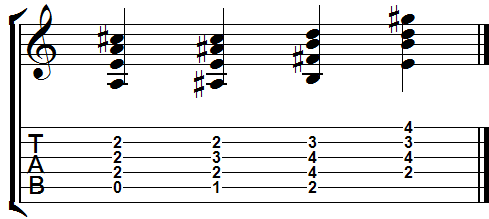
Figure 1 -
A-A#dim-Bm-E7 diminished cliche progression
Chords are commonly combined to create ascending and descending chord progressions. An ascending progression example is iii-IV-V (C#m-D-E), and a
descending progression is I-vii-vi (A-G#dim-F#m). A standard Rock n’ Roll style song could use an ascending chord progression like
this, I-IV-V (A, D, E). A great Flamenco style descending chord progression is i-bVII-bVI-V (Am, G, F, E). An ascending Flamenco chord progression
example is i-bII-bIII (Am-Bb-C). Notice the direction of the step numbers to help determine if the chord progression is ascending or descending.
Motionless chord progressions can be enhanced using bass runs and Chromatic Embellishment of Static Harmony (CESH). For example, playing a D major
chord for several measures is a motionless chord progression because there is no motion or change in the chord progression. Instead, try
a D/C#-D/C-D/B-D/Bb descending bass run to add more variety and interest. CESH chord progressions have a half step chromatic movement in them. For
example, try a chord progression like this, Cm-Cm(maj7)-Cm7-Cm6, a CESH descending chromatic movement. This CESH movement comes from the change in
chord type, not in the chord’s root note. This example’s chromatic movement is C (min), B (maj7), Bb (m7), A (m6), which descends a half step with
each chord change. Instead of just playing a C chord by itself, try a C ascending augmented progression, C-Caug-C6 (Am7)-C7. Notice in many of these
examples the simple half step chromatic movements, changing one note in the chord progression at a time. These examples work great to add a degree of
movement to the otherwise motionless chord progressions. Figure 2 demonstrates the Cm-Cm(maj7)-Cm7-Cm6 chord progression.
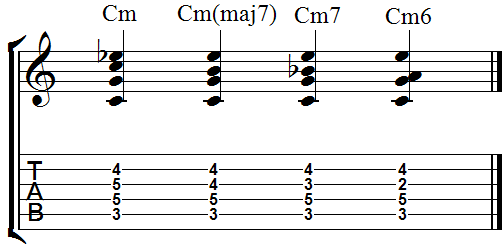
Figure 2 -
Cm-Cm(maj7)-Cm7-Cm6 chord progression
Chord progressions can also utilize chromatic movements called Passing Chords. For example, in a V-IV chord progression using the C major
scale, use the Gb chord as a passing chord between the G and F chord change. The passing chord is creating a chromatic movement from the G
chord to the F chord.
Another chord progression example, called Pedal Point, uses a common note between all chords to create a sustained tone. For example, the C, Em, and
Am chords share the E note. The E note is also the third note in the C major scale (C, D, E, F, G, A, B). The figure 3 example below shows these
three chords with the E note as the highest pitch note. This common note creates a smooth chord transition between these three chords.
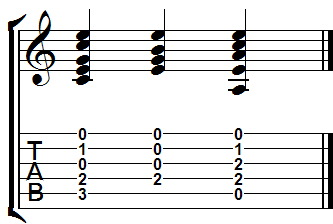
Figure 3 -
Pedal Point C, Em, Am Chord Example
Chord progressions are also used to close a song or a particular section with Cadences. Cadences most commonly resolve (brings a sense of closure) back
to the tonic note or chord. Chord resolution occurs because every chord has a different feeling of tension and release with the tonic chord.
The next few examples will use the major scale. The first cadence is the Authentic Cadence, a V-I chord change. With
major scales, the fifth (V) step chord resolves to the first (I) step chord best because it contains the seventh step note, which is a leading note up
to the root note. This creates a strong feeling of resolution. So, in the C major scale (C, D, E, F, G, A, B), the fifth step chord is G (G-B-D), and
G has the leading note B. Substituting the G chord with G7 (G-B-D-F) also resolves very nicely to the root note because the seventh step note F leads
to the root chord’s third step, which is the E note in the C root chord (C-E-G). Since the leading note B resolves to the root note C, the B
diminished (B-D-F) and B diminished seventh (B-D-F-G#) chords also resolve nicely to the C chord, although they are not authentic
cadences. Figure 4 below shows these cadences.
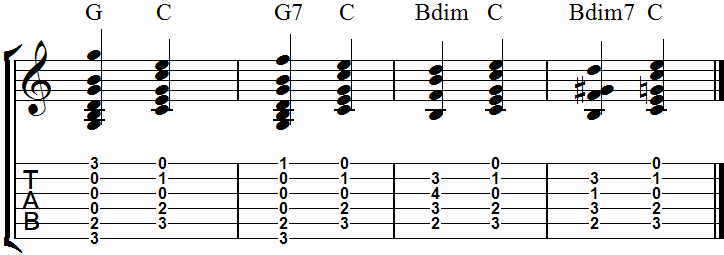
Figure 4 -
Authentic cadences
When the fourth (IV) step chord resolves to the root chord, it is a called Plagal Cadence. This resolution feels like it should raise to the V
chord, but instead resolves down to the I chord. A Double Plagal Cadence adds a flat seventh (bVII) step major chord before the IV chord. Using
the C major scale, the chords would be Bb (bVII or IV of the IV), F (IV), and C (I). A Minor Plagal Cadence is a iv-I chord change, such as Fm
to C. An example of a backdoor dominant chord substitution would be replacing the iv chord with a bVII7 chord, such as replacing Fm with Bb7 in
the key of C. These examples are shown below with figure 5.

Figure 5 -
Plagal cadences
Some chords resolve nicely to the fifth step (V) chord. These are Half Cadences. The second step and fourth step chords can resolve to the fifth
step chord. The ii-V-I leads us to our jazzy chord progression, and the I-IV-V leads us to our blues progression. Lastly, the vi chord (Am) resolves
to the ii chord (Dm) because the vi chord is the dominant or fifth step of the ii chord (just like the ii step is the dominant of the V step).
Cadences are also often used in Turnarounds, repeating back to a section of music. For example, turnarounds are used at the end of 12-bar blues, the
last two measures. This makes it easier on the listener’s ear to hear when the song is going back to the beginning of a particular section. One
popular turnaround is the Imaj7-vi7-ii7-V7 (Cmaj7-Am7-Dm7-G7). Often, the dominant seventh chord is substituted with a tritone, such as replacing
G7 with Db7. This tritone substitution has two common notes between the two chords, B and F. This Db7 chord is also acting as a passing chord to
the C chord. Figure 6 below demonstrates this turnaround.
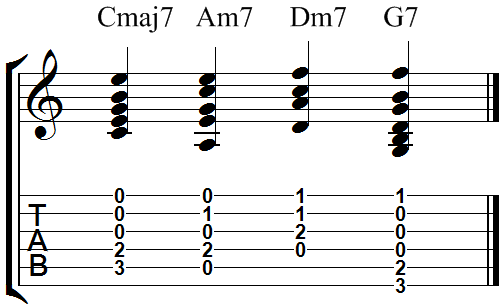
Figure 6 -
Cmaj7-Am7-Dm7-G7 turnaround
The previous examples used the major scale notes for all the chord progressions. Here are a few examples using some other common scales like
the minor, harmonic minor, and melodic minor scales.
Try these chord progressions from the minor scale; (V - IV - I), (bVII - IV - I), (bVI - bVII - I), (IV - bVII - I), (bVI - V - I), (IV - V - I).
|
Minor Chord Progressions
|
|
V
/ / /
|
IV
/ / /
|
I
/ / /
|
|
bVII / /
/
|
IV
/ / /
|
I
/ / /
|
|
bVI / /
/
|
bVII /
/ /
|
I
/ / /
|
|
IV
/ / /
|
bVII /
/ /
|
I
/ / /
|
|
bVI /
/ /
|
V
/ / /
|
I
/ / /
|
|
IV
/ / /
|
V
/ / /
|
I / / /
|
Table 2 - Minor chord progression examples
Try these chord progressions from the harmonic minor scale; (IV - V - I), (V - IV - I), (bVI - V - I), (V - bVI - I).
|
Harmonic Minor Chord Progressions
|
|
IV
/ / /
|
V
/ / /
|
I
/ / /
|
|
V / /
/
|
IV
/ / /
|
I
/ / /
|
|
bVI / /
/
|
V /
/ /
|
I
/ / /
|
|
V
/ / /
|
bVI /
/ /
|
I
/ / /
|
Table 3 - Harmonic minor chord progression examples
Try these chord progressions for the Melodic Minor scale; (IV - V - I), (II - V - I), (bVII- IV – I).
|
Melodic Minor Chord Progressions
|
|
IV
/ / /
|
V
/ / /
|
I
/ / /
|
|
II / /
/
|
V
/ / /
|
I
/ / /
|
|
bVII / /
/
|
IV /
/ /
|
I
/ / /
|
Table 4 - Melodic minor chord progression examples
These chord progression examples all end with the root note chord to demonstrate various cadences. Remember, the purpose of cadences is to bring
that sense of closure to the phrase, like the punctuation at the end of a sentence!
It is clear now that chord progressions are very important to understand and practice frequently. Practice creating unique and interesting chord
progressions, and then practice different scales alongside those chord progressions. To become a better musician, study songs that use many of these
chord progressions and cadences to hear how other musicians have used these techniques. Then, practice creative variations that can help develop an
original style. Experiment with different rhythms and chord substitutions to insure that the chord progressions sound interesting and
creative. This will help each musician develop their own unique sound and composing style!